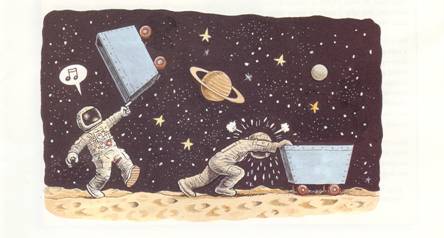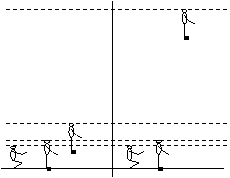Forum on Education of The American Physical Society
Summer 2007 Newsletter
Active PhysicsArthur Eisenkraft NASA is planning a moon habitat where people will live for extended periods of time. Recognizing that the colonists must exercise, NASA has asked for physicists to create, adapt or invent a sport that can be played on the moon. The proposal for this moon sport should include a description of the rules and regulations of the sport, a comparison of the laws of physics on the Earth and moon and a newspaper article describing a championship match for this sport for the people back home on the Earth. This is one of the monthly challenges that high school students get involved with in Active Physics. The act of inventing a sport that can be played on the moon would stretch professional physicists, college graduates and high school students. Although we may hold different expectations for each group in terms of the mathematics and detail of the physics principles, all will be involved in learning and applying physics to their solutions. Physicists may have a good idea as to where they would start in creating a proposal for a moon sport. They probably know something about sports and certainly know both the applicable physics and moon factors (e.g. one-sixth the gravitational field strength of the Earth, no air outdoors, large temperature variations and much smaller than the Earth.) Before reading further, readers may want to pause for a few moments and map out how their favorite sport would have to be modified for play on the moon. How do high school students who do not know physics or information about the moon succeed in creating the proposal? Active Physics guides students and helps them learn and apply physics. The program is built on research results from studies in cognitive sciences 1, student assessment 2, student engagement 3, and problem-based learning . It supports inquiry in the classroom and meets the expectations of the National Science Education Standards 5, the AAAS Benchmarks 6 and state frameworks from across the United States . The "sports on the moon" unit follows the same format as all of the monthly chapter challenges. After being introduced to the challenge, students develop the criteria that are needed for success on the project. For example, what percentage of points of the final project should go to the comparison of physics on the Earth and moon, what percentage to the rules and regulation of the sport and what percentage to the newspaper article? Furthermore, how many physics factors should be included to earn all credit for Earth/moon physics comparisons? The initial criteria set on day one will be revisited before the final proposal is due. The task of setting the rubric clarifies the requirements and provides a window onto students' initial ideas about the project. Each physics topic is introduced using a 7E instructional model. 7Students are asked "What do you see?" in a physics cartoon illustration (drawn by a celebrated MAD magazine cartoonist).
Figure 1
For example, what does the cartoon above tell you? Is this what you would expect on the moon? Is it different than what you experience on the Earth? In the cartoon shown, students can see that it appears to be difficult for someone to push a cart on the moon while it is comparatively easy for someone to lift the same item. The activity will help students explain the differences between mass and weight. The distinction is much easier for students when discussing objects on the moon than a similar discussion for objects on the Earth. The use of the cartoon engages students while also eliciting their prior understandings. Research results strongly support eliciting students' prior understandings as an introduction to any lesson. In addition, visual learners as well as English language learners and special needs students are able and willing to participate in class discussions about what they see in the cartoon while these same students become hesitant when asked a verbal question. It has been encouraging to witness increased class participation from the cartoons and disappointing to find that some physics teachers see a cartoon and conclude that this lesson will not include meaningful physics because a cartoon exists. The "What do you see?" is followed by a "What do you think?" question. In the lesson about friction on the moon, students are asked "How do frictional forces on the Earth and Moon compare?" Their answers reveal what they may remember about friction in general and how they may relate this to friction on the moon. The purpose of this question is not to reach closure, but rather to find out about students' prior understandings. The 7E Instructional Model ENGAGE --> ELICIT --> EXPLORE --> EXPLAIN --> ELABORATE --> EXTEND
Figure 2 The students then embark on an activity. In the friction activity, students first get a kinesthetic understanding of friction by walking across the room and noting the direction of the push of their feet as they move forward. They then quantitatively measure the frictional force by pulling a box of sand at a constant velocity on a smooth table. After graphing the results of multiple trials, students are able to conclude that the frictional force is proportional to the weight of the box. They are then guided back to an earlier activity, where they learned that objects have one-sixth the weight on the moon. They are then able to conclude that the frictional forces on the moon will be one-sixth the frictional forces on the Earth. Most physics lessons would end with this analysis of physics. Active Physics students must then transfer this knowledge to their chapter challenge and their sport for the moon. The activity shows that people will be slipping and sliding all over the Moon. Students must respond to this discovery by creating adaptations to sports to take into account the decrease in friction. Will the players on the moon wear different shoes (Velcro shoes?) or will the shuffleboard court be longer or roughed up? Will baseball players still slide into second base? In a similar fashion, students learn other concepts. Each lesson begins with "What do you see?" and "What do you think?" followed by an activity. The activity is then interpreted, explained and referenced in a discussion of the relevant physics concept. That concept learning is then tested with traditional problem sets followed by a transfer of learning as students further adapt their sport to take into account their new knowledge of physics. These activities help students explore trajectories on the moon, jumping on the moon, mass versus weight on the moon, and the period of a compound pendulum on the moon (which relates to walking and running.)
Figure 3: Comparison of a home run (left) and comparison of jumps (right) on the Earth and Moon as completed by students during the corresponding activities in Active Physics. The chapter challenge is then completed by each student team. The strength of the model is that students take ownership of the physics as they creatively transfer the content of the chapter into an original adapted sport. When they present their sport to the class, the members of the class note how the physics is applied to each new sport. In this way, the class gets to review the content multiple times in different contexts. Learning takes place while completing the activities but additional learning takes place during the transfer from activity to challenge. Students are motivated since they are working on original products and, even though all students have expertise with respect to friction or trajectories on the moon, each group has unique expertise as to how the physics can be adapted in their sport. Finally, the sport allows students to take pride in their interests and/or culture with Latino students choosing soccer with their favorite Brazilian or Colombian teams or other students choosing sports which are meaningful to them like skateboarding or NASCAR. After the "Sports on the Moon" unit is completed, the cycle is repeated with other monthly chapter challenges. Students design an improved safety device for a car as they learn Newton 's laws. Students create an entertaining light and sound show for their friends as they increase their expertise in waves and light. Students assemble appliance packages that can be used in developing nations or in disaster relief environments where electricity is supplied by wind generators with power and energy limitations. Students develop a model of the atom or the nucleus for a science museum exhibit as well as creating something related to the exhibit that can be bought in the museum gift shop. All of these challenges are real challenges in that adults get paid to perform them. Students in Active Physics next ask, "Why am I learning this?" because they are constantly reminded of the challenge and recognize that the content of the course will help them in their execution of the challenge. It is useful to contrast the traditional physics textbook and its approach to learning with the Active Physics text with its attempt to bridge research in learning and practice in the classroom. In both traditional texts and Active Physics, there is content (For You to Read), equations (Physics Talk) and homework (Physics to Go). In Active Physics, students also have a challenge to frame the content, an opportunity for teachers to elicit prior understanding (What do you think?), a need for students to transfer their knowledge at the activity level (Reflecting) and the chapter level (challenge project). In addition, Active Physics has opportunities for additional inquiry activities for highly motivated students (Stretching) and a connection to engineering design (mini-challenge and in the challenge project.)
Figure 4 Active Physics is an NSF supported project that was first conceived and developed by physicists and physics teachers under the auspices of AAPT and AIP. Its major goal is to increase the number of high school physics students exposed to quality physics instruction and it has been meeting that goal as students of all ability levels have been introduced to physics for the first time. No longer need high school physics be limited to the strongest academic students. No longer should the physics community be satisfied with 30% of high school graduates taking a physics course. We now have almost all students in Boston High Schools, Los Angeles High Schools and a host of other cities and districts enrolled in a physics course and finding out that they can do physics and appreciate physics through the Active Physics challenges.. More information about Active Physics can be found at www.its-about-time.comBransford, J.D., A.L. Brown, and R.R. Cocking, eds. 2000. How People Learn. Washington , D.C. : National Academy Press. Knowing what students know Pellegrino J.W., N. Chudowsky, and R. Glaser, eds. 2001 Knowing what students know. Washington , DC : National Academy Press. Perrine , Perrone, V. 1994. How to engage students in learning. Educational Leadership 51(5): 11-13. Delisle, R. 1997. How to use problem-based learning in the classroom. Alexandria , VA : Association for Supervision and Curriculum Development. National Research Council (NRC). 1996. National science education standards. Washington , DC : National Academy Press. Benchmarks for Scientific Literacy. 1993. American Association for the Advancement of Science (AAAS). Oxford University Press. New York . Eisenkraft, A. 2003. Enhancing the 5E model. The Science Teacher 70(6): 56-59. Arthur Eisenkraft is the Distinguished Professor of Science Education at the University of Massachusetts Boston, Director of the Center of Science and Mathematics in Context (COSMIC) and project director of Active Physics. |


